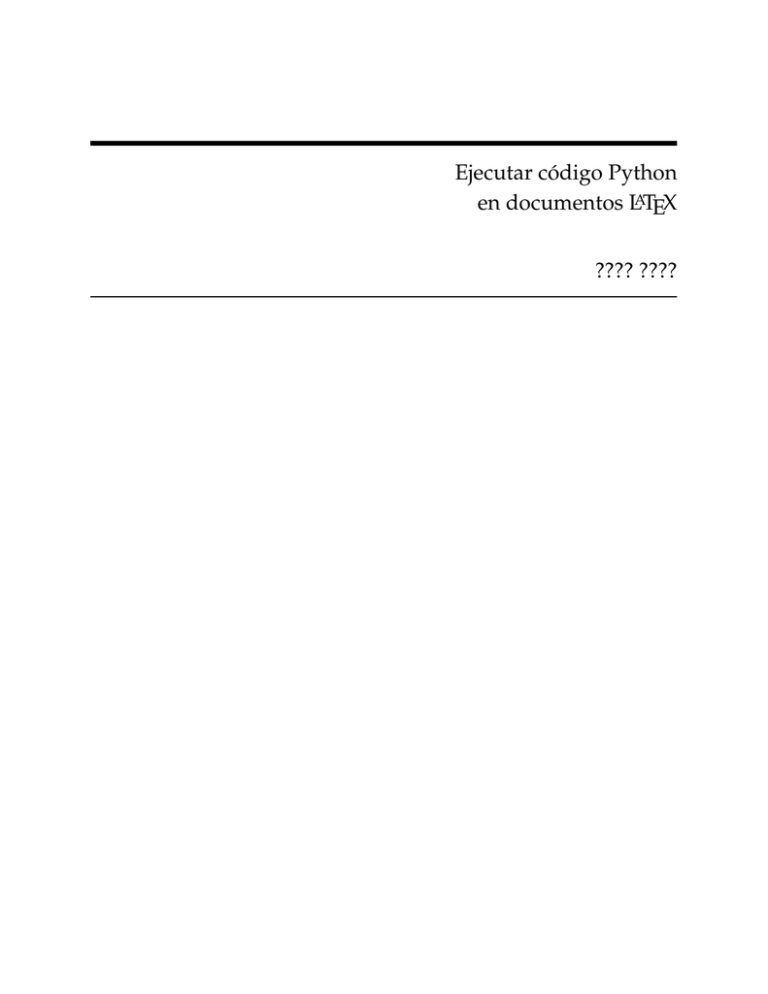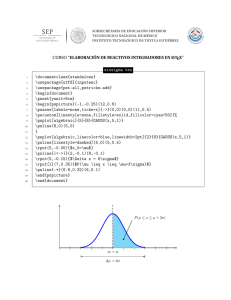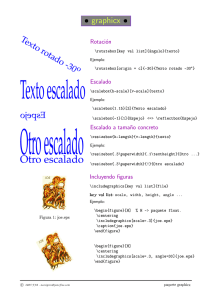Ejecutar código Python en documentos LATEX ???? ????
Anuncio

Ejecutar código Python
en documentos LATEX
???? ????
1
Agregando python.sty
Para poder ejecutar código Python en LATEX se debe habilitar shell escape:
3
El archivo de estilo necesario es python.sty creado por Martin R. Ehmsen:
Crear una carpeta llamada python:
Copiar el archivo python.sty en la carpeta python:
4
Actualizar los archivos de MiKTeX:
Agregando python.sty
2
2.1
Ejemplos simples
Impresión de números
Mostrando números del 0 al 100:
Programa 2.1:
for i in range(101):
print i
0 1 2 3 4 5 6 7 8 9 10 11 12 13 14 15 16 17 18 19 20 21 22 23 24 25 26 27 28 29 30 31 32 33 34 35 36 37 38 39 40 41
42 43 44 45 46 47 48 49 50 51 52 53 54 55 56 57 58 59 60 61 62 63 64 65 66 67 68 69 70 71 72 73 74 75 76 77 78 79
80 81 82 83 84 85 86 87 88 89 90 91 92 93 94 95 96 97 98 99 100
\documentclass[10pt,letterpaper,final]{book}
\usepackage[utf8]{inputenc}
\usepackage[spanish]{babel}
\usepackage{amsmath}
\usepackage{amsfonts}
\usepackage{amssymb}
\usepackage{graphicx}
\usepackage{python}
\begin{document}
\begin{python}
for i in range(101):
print i
\end{python}
\end{document}
2.2
Impresión de texto
Mostrando el típico ’Hola mundo’:
6
Ejemplos simples
Programa 2.2:
print ’Hola mundo’
Hola mundo
\documentclass[10pt,letterpaper,final]{book}
\usepackage[utf8]{inputenc}
\usepackage[spanish]{babel}
\usepackage{amsmath}
\usepackage{amsfonts}
\usepackage{amssymb}
\usepackage{graphicx}
\usepackage{python}
\begin{document}
\begin{python}
print ’Hola mundo’
\end{python}
\end{document}
2.3
Matrices
Usando Sympy:
Programa 2.3:
from sympy import Matrix, latex
A = Matrix([[1, 2, 3], [4, 5, 6], [7, 8, 9]])
print latex(A, mode=’inline’)
print latex(A, mode=’equation’)
print latex(A, mode=’equation*’)
h1 2 3i
456
789
h1 2 3i
456
789
h1 2 3i
456
789
\documentclass[10pt,letterpaper,final]{book}
\usepackage[utf8]{inputenc}
\usepackage[spanish]{babel}
\usepackage{amsmath}
\usepackage{amsfonts}
\usepackage{amssymb}
(2.1)
7
\usepackage{graphicx}
\usepackage{python}
\begin{document}
\begin{python}
from sympy import Matrix, latex
A = Matrix([[1, 2, 3], [4, 5, 6], [7, 8, 9]])
print latex(A, mode=’inline’)
print latex(A, mode=’equation’)
print latex(A, mode=’equation*’)
\end{python}
\end{document}
2.4
Ecuaciones
Usando Sympy:
Programa 2.4:
from sympy import Symbol, Integral, latex
x = Symbol(’x’)
print latex(Integral(x**2, x), mode=’inline’)
print latex(Integral(x**2, x), mode=’equation’)
print latex(Integral(x**2, x), mode=’equation*’)
R 2
x dx
Z
x2 dx
Z
x2 dx
\documentclass[10pt,letterpaper,final]{book}
\usepackage[utf8]{inputenc}
\usepackage[spanish]{babel}
\usepackage{amsmath}
\usepackage{amsfonts}
\usepackage{amssymb}
\usepackage{graphicx}
\usepackage{python}
\begin{document}
\begin{python}
from sympy import Symbol, Integral, latex
(2.2)
8
Ejemplos simples
x = Symbol(’x’)
print latex(Integral(x**2, x), mode=’inline’)
print latex(Integral(x**2, x), mode=’equation’)
print latex(Integral(x**2, x), mode=’equation*’)
\end{python}
\end{document}
2.5
Gráficos
Usando Matplotlib y Numpy:
Programa 2.5:
import numpy as np
import matplotlib.pyplot as plt
xi = np.array([1.4, 0.8, 3.2, 1.8])
yi = np.array([9.0, 2.3, 10.0, 17.0])
plt.scatter(xi,yi)
plt.savefig(’scatter.png’)
\documentclass[10pt,letterpaper,final]{book}
\usepackage[utf8]{inputenc}
\usepackage[spanish]{babel}
\usepackage{amsmath}
\usepackage{amsfonts}
\usepackage{amssymb}
\usepackage{graphicx}
\usepackage{python}
\begin{document}
\begin{python}
import numpy as np
import matplotlib.pyplot as plt
xi = np.array([1.4, 0.8, 3.2, 1.8])
yi = np.array([9.0, 2.3, 10.0, 17.0])
plt.scatter(xi,yi)
plt.savefig(’scatter.png’)
\end{python}
9
\includegraphics[scale=0.9]{scatter}
\end{document}
2.6
Tablas
Una tabla simple:
Programa 2.6:
print
print
print
print
print
for i
r’Tabla \LaTeX’
r’\begin{tabular}{|c|c|c|}’
r’\hline’
r’Fecha & H$\ (m.)$ & Q $\ (m^{3}/seg)$ \\’
in range(30):
10
Ejemplos simples
print r’%2.3f & %2.3f & %2.3f \\’ % (i, i, i)
print r’\hline’
print r’\end{tabular}’
Tabla LATEX
Fecha H (m.)
0.000
0.000
1.000
1.000
2.000
2.000
3.000
3.000
4.000
4.000
5.000
5.000
6.000
6.000
7.000
7.000
8.000
8.000
9.000
9.000
10.000 10.000
11.000 11.000
12.000 12.000
13.000 13.000
14.000 14.000
15.000 15.000
16.000 16.000
17.000 17.000
18.000 18.000
19.000 19.000
20.000 20.000
21.000 21.000
22.000 22.000
23.000 23.000
24.000 24.000
25.000 25.000
26.000 26.000
27.000 27.000
28.000 28.000
29.000 29.000
Q (m3 /seg)
0.000
1.000
2.000
3.000
4.000
5.000
6.000
7.000
8.000
9.000
10.000
11.000
12.000
13.000
14.000
15.000
16.000
17.000
18.000
19.000
20.000
21.000
22.000
23.000
24.000
25.000
26.000
27.000
28.000
29.000
\documentclass[10pt,letterpaper]{book}
\usepackage[utf8]{inputenc}
\usepackage[spanish]{babel}
\usepackage{amsmath}
\usepackage{amsfonts}
\usepackage{amssymb}
\usepackage{graphicx}
\usepackage{python}
\begin{document}
11
\begin{python}
print r’Tabla \LaTeX’
print
print r’\begin{tabular}{|c|c|c|}’
print r’\hline’
print r’Fecha & H$\ (m.)$ & Q $\ (m^{3}/seg)$ \\’
for i in range(30):
print r’%2.3f & %2.3f & %2.3f \\’ % (i, i, i)
print r’\hline’
print r’\end{tabular}’
\end{python}
\end{document}

